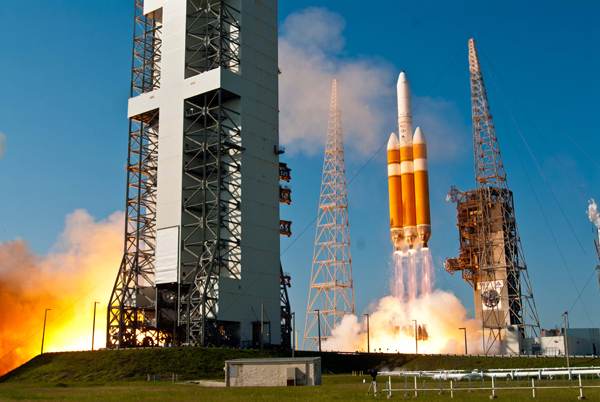Delta 4 boosts secret military satellite into orbit (UPDATED)
Editor's note...
CBS News
A United Launch Alliance Delta 4 rocket, the most powerful in the post-shuttle U.S. inventory, boosted a top-secret National Reconnaissance Office spy satellite into space early Friday after a spectacular morning launch from Cape Canaveral.
Running three hours late because of unrelated technical snags, the 232-foot-tall rocket, made up of three liquid-fueled common core boosters and a powerful upper stage, roared to life at 9:15 a.m. EDT (GMT-4) and quickly climbed away from launch complex 37 at the Cape Canaveral Air Force Station.
Generating more than 2 million pounds of thrust from three upgraded Pratt & Whitney Rocketdyne RS-68A first stage engines, the rocket quickly accelerated as it consumed its liquid oxygen and hydrogen fuel, arcing away to the East atop a fiery plume of exhaust visible for miles around.
The two outside common core boosters separated and fell away as planned four minutes after liftoff and the central core's single RS-68A engine continued to burn for another minute and 40 seconds or so before shutting down and dropping away.
The rocket's second stage, powered by a single Pratt & Whitney hydrogen-fueled RL10B-2 engine, ignited a few seconds later and a minute after that, the protective payload fairing separated and fell away, exposing the secret NROL-15 satellite payload to space.
At that point, in keeping with standard NRO policy, United Launch Alliance commentary ended and no other details about the flight were provided. But six hours later, the company released a statement calling the flight a success, indicating the satellite reached its intended preliminary orbit.
"Today's successful launch of the NROL-15 mission is the third of four launches for the NRO this year and the second EELV launch for the NRO in just nine days," Jim Sponnick, ULA vice president for mission operations, said in the statement. "We congratulate the combined NRO, U.S. Air Force and ULA team along with our mission partners for their continued focus on mission success as we deliver the critical capabilities to support the soldiers, sailors, airmen and Marines."
This was the 20th Delta 4 launch since 2002 and the sixth flight of the most powerful three-core version.
- Posted at 09:35 AM EDT, 06/29/12: Delta 4 boosts secret military satellite into space
- Updated at 03:35 PM EDT, 06/29/12: Adding United Launch Alliance statement; photograph
CBS News
A United Launch Alliance Delta 4 rocket, the most powerful in the post-shuttle U.S. inventory, boosted a top-secret National Reconnaissance Office spy satellite into space early Friday after a spectacular morning launch from Cape Canaveral.
Running three hours late because of unrelated technical snags, the 232-foot-tall rocket, made up of three liquid-fueled common core boosters and a powerful upper stage, roared to life at 9:15 a.m. EDT (GMT-4) and quickly climbed away from launch complex 37 at the Cape Canaveral Air Force Station.
 |
| A Delta 4 rocket carrying a secret military satellite blasts off from the Cape Canaveral Air Force Station carrying a classified National Reconnaissance Office satellite. (Credit: Pat Corkery/United Launch Alliance) |
Generating more than 2 million pounds of thrust from three upgraded Pratt & Whitney Rocketdyne RS-68A first stage engines, the rocket quickly accelerated as it consumed its liquid oxygen and hydrogen fuel, arcing away to the East atop a fiery plume of exhaust visible for miles around.
The two outside common core boosters separated and fell away as planned four minutes after liftoff and the central core's single RS-68A engine continued to burn for another minute and 40 seconds or so before shutting down and dropping away.
The rocket's second stage, powered by a single Pratt & Whitney hydrogen-fueled RL10B-2 engine, ignited a few seconds later and a minute after that, the protective payload fairing separated and fell away, exposing the secret NROL-15 satellite payload to space.
At that point, in keeping with standard NRO policy, United Launch Alliance commentary ended and no other details about the flight were provided. But six hours later, the company released a statement calling the flight a success, indicating the satellite reached its intended preliminary orbit.
"Today's successful launch of the NROL-15 mission is the third of four launches for the NRO this year and the second EELV launch for the NRO in just nine days," Jim Sponnick, ULA vice president for mission operations, said in the statement. "We congratulate the combined NRO, U.S. Air Force and ULA team along with our mission partners for their continued focus on mission success as we deliver the critical capabilities to support the soldiers, sailors, airmen and Marines."
This was the 20th Delta 4 launch since 2002 and the sixth flight of the most powerful three-core version.